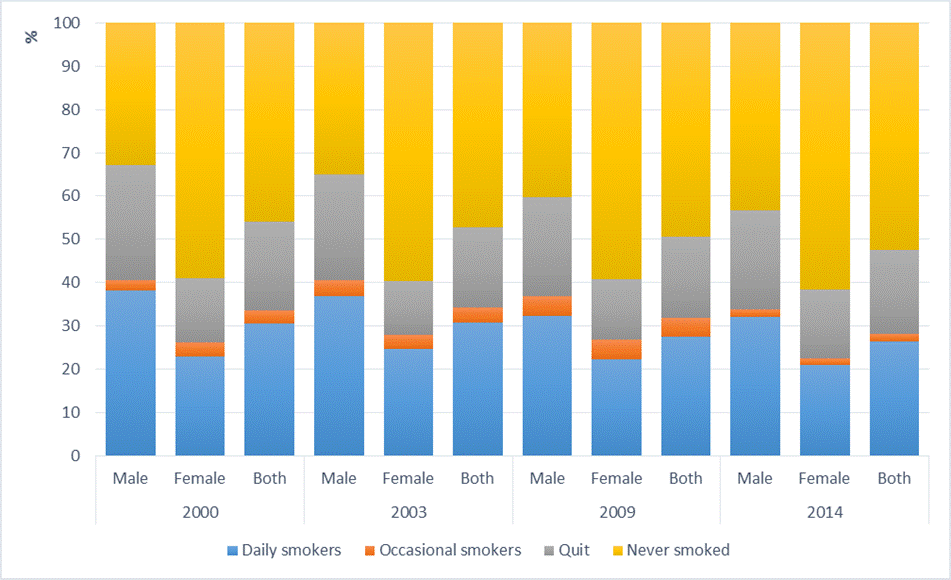Recent manuscripts
Archive
Editorial Board
Aims and Scope
Open Access
Indexing
Contact us
Authorship & COI
Principles of Transparency Checklist
Publication Ethics
Crossmark
Data Policies
Supporting Diversity
Instructions to authors (PDF)
Manuscript Types
Manuscript Formatting
How to submit
Special Publications & Reprints
Preprints
The smoking situation in Hungary
1
National Korányi Institute of Pulmonology, Hungary
Publication date: 2018-03-01
Tob. Induc. Dis. 2018;16(Suppl 1):A265
KEYWORDS
TOPICS
ABSTRACT
Background:
Smoking and related illnesses signify major health and economic concern in Hungary. Accurate understanding of smoking habits is essential in combating smoking.
Methods:
Analysis is based on the anonymized standard European Health Interview Survey (EHIS), conducted in 2009 and in 2014. Statistical analysis explored the associations of socio-demographic variables with daily smoking. Additional data from statistically supported health surveys carried out in 2000 and 2003 were used to determine smoking trends.
Results:
Smoking prevalence in Hungary decreased from the peak 34% in 2003 to 28% in 2014, with 34% of men and 22% of women reported smoking (Figure 1). Increased risk of smoking predominantly affects the 25-34 age group among men (41%) and the 45-54 age group among women (31%). The level of education is more pronounced among men than among women in determining daily smoking (men: 41% vs. 15% low vs. high level of education; women: 25% vs. 12% intermediate vs. high level of education). Employment status, and among women income status less clearly influenced the likelihood of daily smoking. The likelihood of daily smoking however is higher among men facing economic hardship (45% vs. 24% lowest vs. highest household income quintile).

[Prevalence of smoking (%)]
Conclusions:
In recent years, Hungary introduced significant measures to curb smoking: smoking had been restricted in enclosed and in certain open public areas, the number of tobacco points of sale had been drastically reduced and the legally binding increase of excise tax has resulted rising prices. The decreasing smoking prevalence and cigarette consumption may be attributed to restrictive smoking measures. In order to further reduce rate of smoking, particular attention should be paid in the coming years to support and disseminate health promotion programs, specifically aimed at groups with increased risk of smoking, that combat habituation, as well as educate smokers about the harmful effects of smoking and cessation methods.
Smoking and related illnesses signify major health and economic concern in Hungary. Accurate understanding of smoking habits is essential in combating smoking.
Methods:
Analysis is based on the anonymized standard European Health Interview Survey (EHIS), conducted in 2009 and in 2014. Statistical analysis explored the associations of socio-demographic variables with daily smoking. Additional data from statistically supported health surveys carried out in 2000 and 2003 were used to determine smoking trends.
Results:
Smoking prevalence in Hungary decreased from the peak 34% in 2003 to 28% in 2014, with 34% of men and 22% of women reported smoking (Figure 1). Increased risk of smoking predominantly affects the 25-34 age group among men (41%) and the 45-54 age group among women (31%). The level of education is more pronounced among men than among women in determining daily smoking (men: 41% vs. 15% low vs. high level of education; women: 25% vs. 12% intermediate vs. high level of education). Employment status, and among women income status less clearly influenced the likelihood of daily smoking. The likelihood of daily smoking however is higher among men facing economic hardship (45% vs. 24% lowest vs. highest household income quintile).

[Prevalence of smoking (%)]
Conclusions:
In recent years, Hungary introduced significant measures to curb smoking: smoking had been restricted in enclosed and in certain open public areas, the number of tobacco points of sale had been drastically reduced and the legally binding increase of excise tax has resulted rising prices. The decreasing smoking prevalence and cigarette consumption may be attributed to restrictive smoking measures. In order to further reduce rate of smoking, particular attention should be paid in the coming years to support and disseminate health promotion programs, specifically aimed at groups with increased risk of smoking, that combat habituation, as well as educate smokers about the harmful effects of smoking and cessation methods.
CITATIONS (2):
1.
Dialysis patients who smoke are more hypertensive, more fluid overloaded and take more antihypertensive medications than nonsmokers
Mihály Tapolyai, Melinda Forró, Zsolt Lengvárszky, Tibor Fülöp
Renal Failure
Mihály Tapolyai, Melinda Forró, Zsolt Lengvárszky, Tibor Fülöp
Renal Failure
2.
Nationwide lung cancer screening with low-dose computed tomography: implementation and first results of the HUNCHEST screening program
Anna Kerpel-Fronius, Zsuzsanna Monostori, Gabor Kovacs, Gyula Ostoros, Istvan Horvath, Diana Solymosi, Orsolya Pipek, Ferenc Szatmari, Anita Kovacs, Zsolt Markoczy, Livia Rojko, Ferenc Renyi-Vamos, Konrad Hoetzenecker, Krisztina Bogos, Zsolt Megyesfalvi, Balazs Dome
European Radiology
Anna Kerpel-Fronius, Zsuzsanna Monostori, Gabor Kovacs, Gyula Ostoros, Istvan Horvath, Diana Solymosi, Orsolya Pipek, Ferenc Szatmari, Anita Kovacs, Zsolt Markoczy, Livia Rojko, Ferenc Renyi-Vamos, Konrad Hoetzenecker, Krisztina Bogos, Zsolt Megyesfalvi, Balazs Dome
European Radiology
Share
RELATED ARTICLE
We process personal data collected when visiting the website. The function of obtaining information about users and their behavior is carried out by voluntarily entered information in forms and saving cookies in end devices. Data, including cookies, are used to provide services, improve the user experience and to analyze the traffic in accordance with the Privacy policy. Data are also collected and processed by Google Analytics tool (more).
You can change cookies settings in your browser. Restricted use of cookies in the browser configuration may affect some functionalities of the website.
You can change cookies settings in your browser. Restricted use of cookies in the browser configuration may affect some functionalities of the website.

